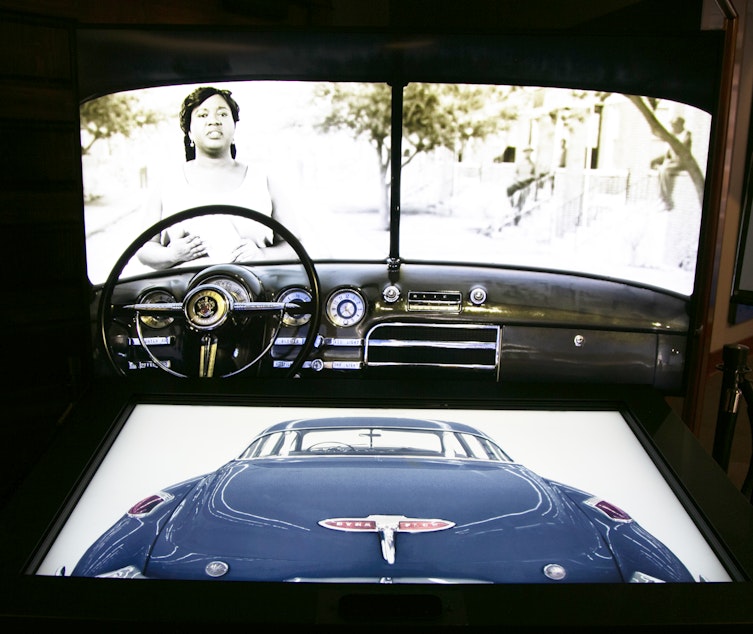New exhibit explores the history and dangers of 'traveling while Black' in the U.S.

Travel represents the freedom to move without care or concern. But during the Jim Crow era, travel was risky if you were Black. The Green Book, a guide for African American travelers, helped them navigate toward places and establishments that were welcoming.
A Smithsonian Institute exhibit in Tacoma looks at how a humble guidebook became an essential resource for African Americans, allowing them to move for work or vacation safely.
Black travelers at the end of the Great Depression had to worry about driving safely to their destination, and a whole lot more.
“You didn’t know if people would be hostile to you,” said Gwen Whiting, lead curator of the Washington State Historical Society.
Whiting said it was common for Black travelers to pack what was called a shoe box lunch, a cooler packed with food for the journey — not for snacking.
“You didn’t know if anyone would allow you to sit down and eat, or even allow you in the gas station and get food or get gas for the journey,” she explained. “It was that level of discrimination we’re talking about.”
That was what Victor Green and his wife Alma encountered when they traveled during that era. When he talked to friends and family, he found out they experienced discrimination on the road, too. So the couple published The Negro Motorist Green Book, a guide that listed gas stations, hotels, and restaurants that were safe places for Black travelers.
Sponsored
When it was first printed in 1936, the Green Book focused on New York. But over the years, it expanded to other states, including Washington.
“I know when people say, 'Gosh, Washington state was in the Green Book?' And I’m like, 'Yeah, because travelers didn’t know what to expect in Washington state,'” said Stephanie Johnson-Toliver, president of the Black Historical Society of Washington State.
Many of the local businesses listed in the Green Book were in Seattle, like Stockard’s Barber Shop on East Madison Street, or The Rocking Chair nightclub on East Yesler Way. You can explore some of the local sites through the Seattle Green Book interactive tour.
The Green Book was more than a travel guide — it helped lift Black-owned businesses across the country. It also helped young entrepreneurs who opened their homes to travelers for a night’s rest and a meal, Johnson-Toliver said. They were known as tourist homes, and they were popular.
Sponsored
“This was a time [when] you couldn’t have a reservation, you couldn’t call them up and say...'I’d like to be there on such and such day, and will my room be ready?” Johnson-Toliver said. “You drove up, you knocked on the door, you were invited in…there was a lot of trust in the tourist homes.”
The last edition of the Green Book was published in 1966, two years after the Civil Rights Act of 1964. Johnson-Toliver said the safety issues of traveling while Black haven’t changed much, and remain relevant today.
“Here we are, still having this discussion about being on the road and being Black, and having to look at your rearview mirror to see who’s behind you, and do you need to slow down, speed up, or pull over?”
The Green Book exhibit runs from March 19 to June 12 at the Washington State Historical Society in Tacoma.
A modern-day version of the Green Book
Sponsored
Anthony and Marlie Love produce the YouTube series Traveling While Black in Seattle. They also rate their experiences as Black people exploring the Puget Sound region.
“Some of the same ideologies that was the foundation for Jim Crow, and the same mindset, still exists,” said Anthony. “If anybody understands why the Green Book was created, they can understand why we do our show today.”
The Loves moved to Seattle from St. Louis, Missouri in 2019. At first, the series was a way to get out and explore the region on those cold, grey days. But then they decided to do more than rate the fun level of the locale.
“A question we had moving up here was, how is it really...the experience for a Black person walking into it?" Anthony Love said. "And when we were moving up, we couldn’t find the resources that spoke to that.”
Sponsored
It's something that’s always in the back of their minds, Marlie Love said.
“As a person of color, I think people don’t realize that there is that anxiety that we have...are we going to be seated, are we going to be served, are we going to get a nice hotel room, or are we going to get a crappy hotel room? You don’t want to spend your money somewhere where you’re going to have a bad experience.”
Marlie and Anthony Love said those concerns may be constant, but they haven’t dampened their enthusiasm for exploring the region and trying new experiences. Just like their fellow travelers decades ago, they find a way to navigate those constraints.




